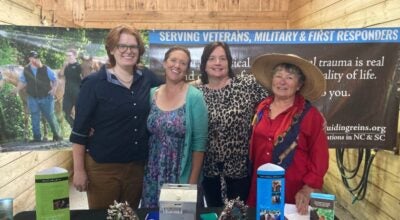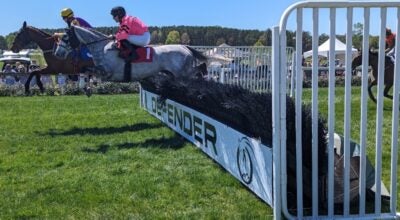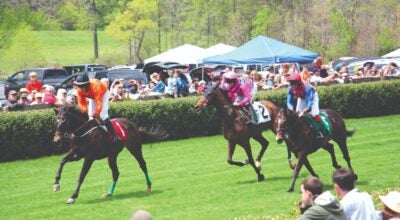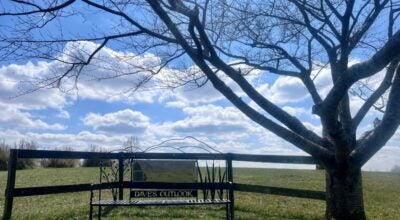Ride is Simulated, Results are Real
Published 4:14 pm Wednesday, February 1, 2017
Between our many well-regarded trainers and frequent clinics by outside experts, local riders of all disciplines have lots of ways to sharpen their skills. Now we have another training option that’s one of just two such opportunities in the United States.
I’m talking about the new equine simulator at Tryon International Equestrian Center, known as “Tryon Maximus,” and his accompanying trainer, Barbro Ask-Upmark. Barbro not only conducts training on the simulator, she also contributed greatly to its development based on her own experience and accomplishments (see box).
Tryon Maximus was manufactured by Racewood Equestrian Simulators, a small family-owned company in the tiny town of Tarporley in northwest England. Racewood has been building horses since 1990 and its realistic racing simulators are used at British jockey schools, where jockeys get certified on simulators much the same as pilots do. Other Racewood models are widely used in Great Britain for general riding instruction and at therapeutic riding programs.
Simulator Advances
The connection between Racewood and Barbro was made through David Hunt, with whom Barbro has been riding for 20 years. Hunt is a former international dressage competitor for Great Britain who is now an international trainer, FEI judge and board member, and member of FEI’s Dressage Judges Supervisory Panel, which oversees judging at the Olympics, World Equestrian Games and World Cup Finals.
Hunt introduced Barbro to Racewood Managing Director Bill Greenwood 10 years ago and she was so impressed with his simulator’s potential that she bought one and took it to a trade show. Within a few months, a trainer asked about leasing it from Barbro; that woman has been using it with students ever since.
Barbro then bought Racewood’s next, more advanced simulator and began asking Greenwood if it would be possible to add “this” capability or “that.” Could a simulator be cued to pick up a right lead canter, or left lead, rather than just “a canter”? Or, “Can you create a dressage horse with an interactive screen of a dressage ring?” “Why do you need that?” Bill would ask, and Barbro would explain the importance of precision in dressage. As advancements were made, Barbro would buy the latest model and sell her prior ones on to individuals or trainers.
Then Barbro asked if Greenwood could make a simulator that would jump. “The jumping was a whole different thing,” Barbro says. “It took about three years just to make the hydraulics that could lift the simulator up.” Barbro’s next request was whether Racewood could make one simulator that could do everything: dressage, show jumping, and cross-country. And could it also have bit sensors and a neck that would move up, down, left and right?
“The bit sensors and moving neck were amazing advancements for teaching contact,” Barbro says. “With real horses, even those that are very well trained, they can quickly figure out the rider and make adjustments to compensate for a rider’s issues. The simulator will not compensate: it will always do the same thing in reaction to your cues, whether they are right or wrong. If you are riding with the right contact, a deep seat, strong core, but your hand gets a little blocked, for example, he will stretch his neck away from you or he will stop. So the rider has immediate and consistent feedback in learning how to do something.”
Tryon Maximus is Racewood’s Eventing model, complete with interactive screens for training on or practicing dressage, show jumping and cross-country phases. He is fully programmable at beginner, intermediate and advanced levels, and can walk, trot, canter, gallop and jump – even cross-country drops.
For all three eventing disciplines, Tryon can be programmed for Instruction or Arena mode. In Instruction, the rider sees onscreen feedback from all of Tryon’s sensors, including seat sensors that evaluate balance (left/right and forward/back) and six leg sensors that indicate rider’s leg position and pressure.
The Arena mode allows someone to ride a dressage test, show jumping course or cross-country, utilizing the three-panel interactive screen to actually “ride” the environment they see. In fact, when Barbro was bringing her horse Monterey to Grand Prix level, she rode a Grand Prix test everyday on her dressage simulator so she could practice it and work on her precision without over-schooling the horse. “Not only did I learn the test, I didn’t even have to really think when I got into the ring to do it – it was the easiest test for me. I knew the test, I knew what to do – it was truly amazing.”
I get to ride
After watching Barbro demonstrate Tryon being ridden for dressage, show jumping and cross-country in the Advanced mode, I had the chance to try him myself. Not being a jumper I opted for dressage in the Instruction mode.
The experience was great fun, which I expected, and I also could immediately see the training benefits: I do sit straight in the saddle but sensors showed that I weight my left seat bone more than my right. And my legs were slightly more forward than I realized, which interfered with leg yield. But Tryon immediately responded when I corrected that. And if I dropped my connection, Tryon would either slow and stretch his neck out or pick up a trot, depending on what my legs were doing.
I even did some beginner-level cross-country and show jumping. While I haven’t taken jumping lessons I’ve read enough George Morris to avoid launching myself up the neck or flinging my legs up behind me. For my Beginner-mode session Tryon was on autopilot but experienced jumpers would be controlling him as they would their own horse on course, with corresponding good or bad results; the Eventing simulators can refuse a jump or be programmed to “fall.”
With everything I tried, I saw how a rider could easily make adjustments based on simulator feedback and ultimately develop different muscle memory to correct bad habits. And the simulator lets a trainer actually place hands on while the rider is riding, rather than just shouting position corrections across a ring.
I was left wishing for a simulator of my own or at least the means to ride one whenever I wanted, so I could see the results on my own horse.
The TIEC Connection
One of Barbro’s earlier dressage simulators, Dante Maximus, went to the World Cup in Las Vegas and then on to Wellington. When Mark and Katherine Bellissimo later wanted to learn more about riding simulators, Racewood put them in touch with Barbro.
“Mark and Katherine have an amazing wish to spread equestrian sport and ‘up’ the level of knowledge about horses, training, and making people better riders,” Barbro said. “Their intentions are the same as my own: to make things better for the horses by teaching riders how to do things correctly. Just getting people to ride straighter is going to help horses. And the simulator opens a whole new perspective: sometimes riders will appear straight to me but the sensors will show me that they’re not.”
Barbro and her personal and business partner Aramis Fontenol recently moved from California to the Tryon area with their company, “Always a Good Ride LLC,” and are now affiliated with Tryon International Equestrian Center.
Barbro and Tryon Maximus are in Wellington for the winter season but will be back soon and available for training sessions, from a single lesson to a packaged series (with onsite lodging available for out-of-towners). Barbro will also continue to do certification sessions for trainers who buy their own simulators so they can learn how to use it with their own clients.
Racewood’s simulators have also been regularly used with disabled riders and those recovering from injuries. “The latest software we are going to add is for autistic riders (children or adults) which will enable them to interact with the screen and experience the sensation of riding,” Barbro said.
To learn more about simulator training sessions on Tryon Maximus, or about buying your own simulator, contact Barbro at baskupmark@tryon.com. •
Barbro’s Background
• Barbro Ask-Upmark grew up in Sweden where she started riding at 7, got her first horse at 10, and participated in multiple sports before focusing on dressage.
• As a mounted patrol officer in Sweden for 15 years, Barbro trained the police horses and riders, and had her own clients on the side.
• At the 1990 European Police Horse Championships Barbro won the dressage silver medal behind Klaus Balkenhol of Germany on “Goldstern.” Two years later that pair won Team Gold and Individual Bronze at the Barcelona Olympics.
• Barbro has competed successfully at FEI levels through Grand Prix in Sweden, Germany and Great Britain on horses she owned and trained.
• Barbro has her US Dressage Federation Bronze, Silver and Gold Medals and is a 5-Star rated instructor.
• Barbro took her Swedish Warmblood “Monterey” from his start at 2.5 years old to Grand Prix at 10; he was Horse of the Year for Swedish Warmbloods in North
America in 2002.
• As a trainer in California, Barbro rode PREs (Pure Spanish Horses), taking “Orive YET” to first place in California and second nationally in the Grand National Champion FEI Intermediare 1 in 2015 and 2016.
• Barbro has ridden for more than 20 years with Great Britain’s David Hunt, who introduced her to the simulators produced by Racewood. She became an expert advisor on simulator development and now represents Racewood in the U.S. Barbro’s business – “Always a Good Ride” – is now based out of TIEC.






